Preservation and politics: The fragility of Panama’s mangrove laws
By Mihiro Shimano

PORTOBELO, Panama – Jason Ashcroft, a conservationist and tour guide based in Portobelo, is paddling his blue kayak through the narrow waterway of the dense mangrove forest located in the Portobelo National Park.
As the kayak scrapes against mangrove roots that jut out of the water, Ashcroft points out a clump of mussels that have attached to the tree’s sinewy roots and nods.
“The mussels growing on the mangroves is an indication of how pure the water is,” Ashcroft says.
This mangrove swamp is protected as part of the Portobelo National Park, which is 139 square miles and a UNESCO World Heritage Site. However, not all mangroves in Panama have the same extensive protection as those located here.
Panama is home to the largest number of mangrove forests in Central America, with approximately 380,500 acres that span across the coastal lines of this crescent-shaped country. Yet, in just the last 50 years, Panama has lost almost 50% of its mangrove forests because of expanding infrastructure and an increase in deforestation to make space for agriculture.
There are several specific Panamanian laws that protect mangroves as well as general environmental laws and administrative resolutions that involve regulations on the protection and granting use of mangroves. However, the country’s pro-development politics often take precedence over conservation efforts, much to the dismay and even fear of those who consider themselves sentinel over the ancient tree.
“Panama is working on a new policy to better preserve mangrove forests, but they will still keep that loophole in for development projects,” said Sarah Fontaine-Chamberland, author of a Panamanian mangrove policy paper and former researcher at the Punta Galeta Marine Laboratory. “It seems like it’s still an unresolved issue, even though they’re very well aware that mangroves are disappearing.”
Roots of the sea
Mangroves makeup only 3% of the world’s forest cover but nevertheless exist in 123 countries, mainly stretched over the central to southern hemisphere. Over the 10 years between 2006 and 2016, 2% of the global mangrove area was lost, mostly due to human activity.
Mangroves can be found in tropical and subtropical regions where fresh water is mixed with salt water, two key ingredients for their survival. In Latin America, they are most prominent in countries such as Brazil, Colombia, Venezuela, Panama, Cuba and Ecuador.
In Panama, there are three common species of mangroves found on both the Caribbean and Pacific coasts – the red mangrove, the white mangrove and the black mangrove. The color can be identified after cutting into the bark. 97% of the mangroves are distributed on the Pacific side, while 3% are found along the Caribbean.
The layer of vegetation provided by the mangroves is vital to the landscape of coastal communities because it provides a necessary barrier from strong waves and winds that arise from storms. The thick and intertwined roots also serve as a haven from predators for many smaller animals such as crabs. Their roots also work hard to take carbon dioxide from the atmosphere to store in the earth.

Mangroves are also a vital weapon against coastal erosion, a natural filter for all the sediment buildup that occurs in the reef coming in from the mainland, as well as a provider of environmental services by filtering out the surrounding water from natural elements such as zinc, magnesium and phosphorus that affects the water composition.
“They provide what many call environmental services because they basically filter a lot of what comes from the mainland,” said Osvaldo Jordán, executive director of the Ramsar Regional Center for Training and Research for the Western Hemisphere (CREHO), based in Panama City. “They have many environmental services and they are really very useful ecosystems.”
Environment versus economics
Panama has several laws related to protecting and conserving mangroves, including Law 41 of 1998, which is the General Environmental Law, and Law 44 of 2006, which is the regulation that created the Aquatic Resources Authority of Panama (ARAP). For example, permits to cut down mangroves are still granted for social interest purposes.
They also have protected status through Panama’s signing of the Ramsar convention on Wetlands of International Importance in 1971, an international governmental treaty on use of wetlands, as well as protection guidelines through other organizations such as the United Nations, International Tropic Timber Organization and the International Society for Mangrove Ecosystems.
However, these existing laws are often not put into practice.
Some areas of mangroves, especially along the Caribbean coast, are diminishing as they are cleared in huge swaths to make way for larger structures and buildings, such as hotels and resorts, or cleared to allow for sandy tourist beaches.
The biggest contributor to the loss of mangroves is development.
“That’s kind of where the heart of the issue lies, since you have these laws that explicitly allow for mangroves to be cut down legally,” said Fontaine-Chamberland. “If you have an environmental impact assessment that is approved, and in general, Panama approves every single project just because they have these pro-development politics, they disregard conservation for the long run.”
One area that has seen an extensive amount of deforestation of mangroves over the past 20 years is Colón, a port city on the Caribbean side of the country, and one of the entryways into the Panama Canal. All of the ports that currently lie in the Colón Free Trade Zone – a re-exporting site for merchandise – used to be mangrove swamps that were landfilled to make space for their construction. As a result of the lack of natural protection from flooding and rising sea levels, the city had to install water pumps at the city gate.
Despite the already existing ports, continuous economic activity due to the canal has led to further infrastructure activity in Colón, including the building of a new mega port on a nearby island, Isla Margarita, which could potentially impact the mangroves lining the island’s coastlines, experts say.

“In general, [the government] is very well aware that mangrove conservation is important, and they do have a will to do something,” Fontaine-Chamberland said. “But it’s just that in general, the environment is at odds with other priorities … just because the overall government’s vision and assembly’s vision is to allow for development to occur.”
The complexity of Panamanian laws surrounding mangrove protection is evident in a resolution passed in 2008 by the Authority on Aquatic Resources or ARAP. The resolution established regulations that included prohibiting the deterioration of the environment and damaging aquatic resources for commercial use. However, it also established fines for cutting mangroves, with a fee of $150,000 per hectare – about .6 of a mile – for commercial projects and $20,000 per hectare for public necessities.
“The separate laws are clear, but the corruption and influence-peddling often cloud the judgment of the authorities when it comes to denying mangrove logging permits, which is clearly to enrich elite groups and not to sustain coastal communities as the law says,” Gabriel Estrada, former mangrove researcher at the Punta Galeta Marine Laboratory, said.
A shifting perspective
Not all, however, is bleak.
Historically for locals, the ecological importance of mangroves was overlooked. A substantial number of low-income families traditionally utilized mangroves to support their livelihood, such as by using the root to make charcoal or by using the bark to create colored dye for traditional leather sandals known as las cutarras.
“In the Panamanian culture, mangroves are dirty, smelly and insect-ridden forests,” Stanley Heckadon, the station director of the Punta Galeta Research Station in Colón, said.
However, Osvaldo Jordán, executive director of CREHO, said he has seen a shift over the years in the general perception toward mangroves.
“It’s changed a lot with the new generations,” Jordán said. “[People] want to protect it, they want to plant it, they are concerned when they are going to be cleared.”
Efforts to conserve mangroves and other coastal environments in Panama are also underway by multiple organizations across Panama. CREHO is an example of an international governmental organization, or IGO, that is one of four regional training centers associated with the Ramsar Convention. Its members work to train mostly government personnel about the existence of these guidelines as well as educate them on how they can be used.
“The government has cared a lot, I mean it’s their duty, not voluntary,” Jordán said. “Their level of cooperation with NGOs also varies a lot. In some places it works fine, and in other places it doesn’t work.”
One study on mangroves in Parita Bay, located on the Pacific coast, west of Panama City, found that there had been a 4.7% increase in mangrove growth from 1987 to 2019. One of the reasons was that reforestation efforts took place through governmental or non-governmental organizations, or NGO, programs.
Certain educational initiatives have also been created to teach young Panamanians about the importance of the environment they live in.
A program that has spearheaded this effort is the Punta Galeta Research Station in Colón. In 2000, Heckadon, the unit’s director, began shifting the main aim of the station from a research institute to a program that linked the research occurring at the station with the Panamanian school system.
The Galeta Point Marine Environmental Education program, which taught students about seagrass beds, corals, mangroves and other marine environments, began with just 60 schoolgirls from a Catholic orphanage in Colón. By the beginning of the pandemic in 2020, approximately 180,000 schoolchildren had gone through the educational program offered by Punta Galeta. Also, in 2006, the station began offering a two-week intensive course to train Panamanian university students on how to teach topics related to coastal tropical habitats and their importance.
“I would say that the Galeta teacher training course on tropical coastal habitat, including mangroves, did more than anything else to change the perception of the Ministry of Education about the importance of coral reefs, seagrass beds and mangroves, the creatures that inhabit them,” Heckadon said.
Other organizations have also followed this effort, including the Panama Audubon Society, which has a Green Classrooms program that provides education material for students and teachers in several Panamanian local schools. There are also other local efforts by schools in Panama to educate and regrow the mangroves in their areas.
“I try to establish bridges between those who know and our education system … I feel it’s my duty to improve the quality of science teaching in the Panamanian school system,” Heckadon said.